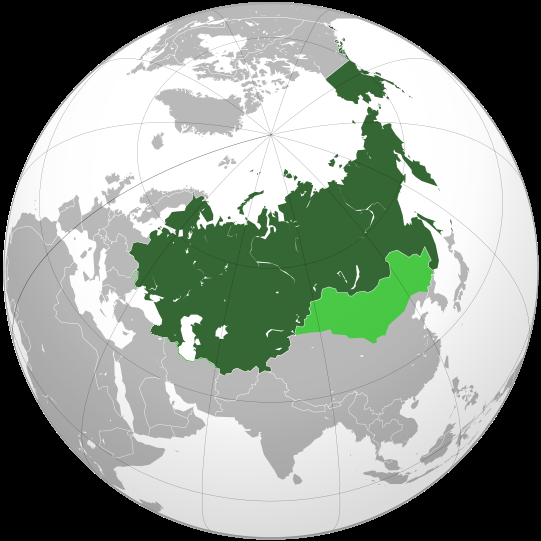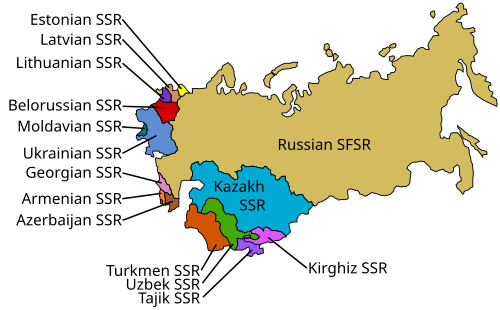
In our Global Archive series, we get to know the world a little better, one country (or territory) at a time. Today’s installment: Russia!

So let’s start at the very beginning. Modern Russia has origins in about the 8th century CE. Vikings (called Varangians by the Greeks) came to rule over the people known as Slavs.
- Is the word slav related to the word slave? Maybe. Some linguists think they have a shared origin in Latin. Slavic people were often enslaved in the 3rd through 8th centuries. It might also be derived from slovo, “word”–people who spoke the same language or “word” might have called each other Slavs, then other people heard them calling each other Slavs, and then decided that that was their name…
In 862, Rurik, a Varangian prince, came to rule over the area around Lake Ladoga, not too far from modern day St. Petersburg. He founded a new settlement at Novgorod. Rurik’s descendants would be the first dynasty of Russian rulers.
By the 9th century, the Varangians had assembled the Slavic tribes into a loose federation of city-states. At the time it was called “the land of the Rus'”–though linguists argue about what Rus’ means. Nowadays it is often called Kievan Rus’, because Kiev became the most powerful city after Novgorod.
Slavs were pagans and worshiped nature. There were at least 6 major gods representing things like thunder, the sun, and women’s work. In 988, the Grand Prince of Kiev, Vladimir, forcibly began converting people to Orthodox Christianity in order to strengthen his relationship with the Byzantine empire. The people did not totally want to give up some of their pagan traditions though, and for years priests complained about “dvoeverie” or having two faiths.

As Kievan Rus’ eventually began to decline, Mongols started invading. Kievan Rus’ fell in 1240 to the “Mongol Yoke.” The cities of Rus’ had to pay tribute to Mongol leaders. Finally, the princes of the city of Moscow got strong enough to fight back in the 1400s, and by 1480, Moscow rose as the new powerful, independent city. It conquered its neighboring areas.
As Kievan Rus’ eventually began to decline, Mongols started invading. Kievan Rus’ fell in 1240 to the “Mongol Yoke.” The cities of Rus’ had to pay tribute to Mongol leaders. Finally, the princes of the city of Moscow got strong enough to fight back in the 1400s, and by 1480, Moscow rose as the new powerful, independent city. It conquered its neighboring areas.

In 1547, Ivan the Fourth, more famously known as Ivan the Terrible, took a new title: The Tsar of All the Russias.
- Ivan’s name in Russian, Иван Грозный, does not mean “Ivan the Terrible”–it means “Ivan the Terrifying.” He was a scary guy!

He conquered the far eastern territories of Kazan and Siberia, and Russia became a multicultural country.
The Romanov dynasty came to power in 1613. They strengthened Russia and kept expanding its borders. By the late 17th century, Russia had absorbed half of Ukraine.
In 1721, Peter I (the Great) named himself emperor. The Russian Empire was born. He built a new capital at St. Petersburg, and led a cultural revolution to modernize Russia. Catherine the Great continued these imperialist ways, and added enormous amounts of land to the empire through conquest and colonization.

Eventually, the empire declined. When Russia entered World War I, the high costs of war and dissatisfaction with corruption led the people to unrest. Two revolutions took place in 1917–the first in February forcing Tsar Nicholas II to abdicate in favor of a Provisional Government and eventually the Russian Republic, and another in October seizing power for the Bolshevik party, led by Vladimir Lenin. By January 1918, the Soviet Union, the world’s first Soviet state, was born.
- The official name was The Union of Soviet Socialist Republics– Союз Советских Социалистических Республик. Soviet refers to the elected council that governed each republic. It is the same word as совет– advice!
- Here are the 15 republics that were part of the Soviet Union: Russian SFSR, Ukrainian SSR, Byelorussian SSR, Uzbek SSR, Kazakh SSR, Georgian SSR, Azerbaijan SSR, Lithuanian SSR, Moldavian SSR, Latvian SSR, Kirghiz SSR, Tajik SSR, Armenian SSR, Turkmen SSR, Estonian SSR (SSR means “Soviet Socialist Republic”)

In order to achieve the monumental goal of modernizing the vast territory of the former Russian empire, the Soviet Union had to be organized. It is no secret that these modernizations, such as the forced collectivization of farmlands, came at an appalling human cost. The Second World War took an enormous toll on the USSR as well; however, the rapid industrialization of the previous decades made for an effective wartime infrastructure.
I think I’ll leave discussion of the rest of the 20th century and beyond for another day, as this post is already getting quite long. To be continued!

You must be logged in to post a comment.